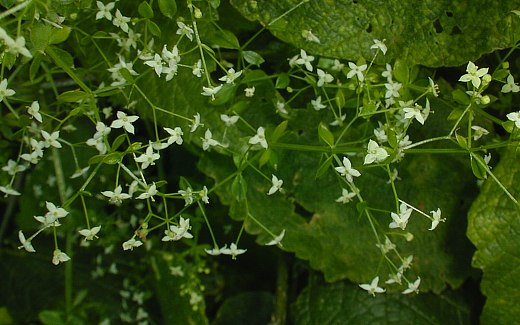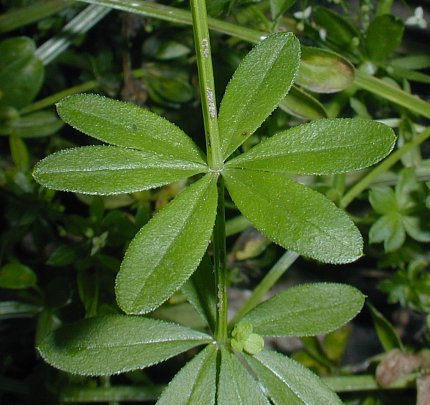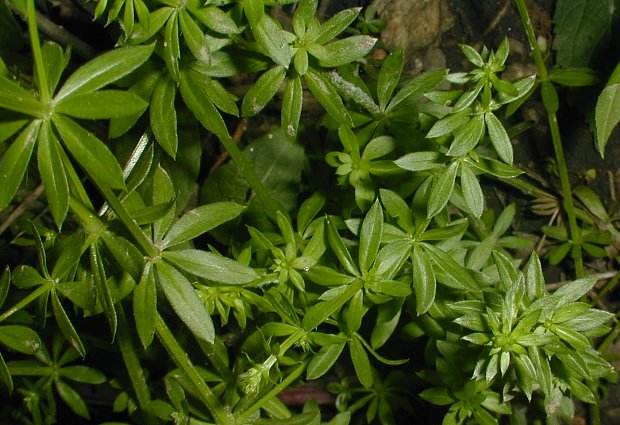Description: This herbaceous perennial plant is 1–2½' long and unbranched, except near the inflorescence. The lower stem is often decumbent along the ground, while the upper stem and inflorescence are more or less erect. In the absence of support from adjacent vegetation, this plant has a tendency to sprawl. The central stem is glabrous, 4-angled, and often furrowed; it becomes slightly swollen where the whorls of leaves occur. Each whorl has 6-8 leaves; these whorls of leaves become rather widely spaced as the central stem elongates. Each leaf is up to 1" long and ¼" across (or slightly larger). It is oblong or oblanceolate, glabrous, and smooth along its margin; sometimes this margin is slightly ciliate. There is a single prominent vein along its upper surface. The foliage of this plant lacks any stiff or clinging hairs.

The central stem
terminates in a panicle of cymes up to 1' long. This panicle is longer
than it is broad and contains a multitude of small white flowers. There
is often a pair of small leaves (or leafy bracts) at the base of each
cyme along the central flowering stalk. Each flower is about 1/6" (4
mm.)
across. It has a white corolla with 4 lobes (rarely 3) and a pair of
ovoid carpels at its base that are green, hairless, and joined
together. The throat of the corolla is quite narrow, from which there
protrudes a pair of styles. Each lobe of the corolla becomes pointed at
its tip. The blooming period occurs from late spring to mid-summer, and
lasts about 1 month. Some plants bloom later than others. Each carpel
contains a seed that is convex on one side and concave on the other.
The root system is rhizomatous and can produce numerous vegetative
offsets.
Cultivation:
This plant can be found growing in light shade to full sun in more or
less mesic conditions. It becomes larger in fertile loam, but can grow
in other kinds of soil.

Range &
Habitat:
The non-native Hedge Bedstraw is an uncommon plant that occurs
primarily in northern
Illinois (see Distribution
Map). This species is native to Europe and it is more common
in the Eastern states; Illinois lies at the western end of its
distribution (excluding where it occurs along the Pacific Coast).
Habitats include areas along railroads and roadsides, thickets,
woodland borders, and various waste places. Hedge Bedstraw is currently
found in areas with a history of disturbance.
Faunal Associations:
According to Müller of 19th century Germany, the small amount of nectar
in the flowers attracts various kinds of flies, including soldier
flies, bee flies, Syrphid flies (which also feed on the pollen), Muscid
flies, crane flies, and dung flies. It is possible that small bees also
visit the flowers, but they are probably less common. The foliage or
flowers of Galium
spp. (Bedstraws) are eaten by the caterpillars of several
moths, including Lobocleta ossularia (Drab Brown
Wave), Pleuroprucha insulsaria (Common Tan Wave),
and Scopula limboundata (Large Lace Border). Little
information is available about this species' relationship to birds and
mammalian herbivores. Because the carpels of Hedge Bedstraw lack
bristly hairs, they don't cling readily to the fur of mammals or the
clothing of humans.

Photographic
Location:
Several plants were growing at the edge of a wooded area along a
railroad in Urbana, Illinois. Some of the neighboring plants included Tradescantia
virginiana (Virginia Spiderwort), Arctium minus
(Common Burdock), and Toxicodendron radicans
(Poison Ivy). Some flowers of the photographed flowering plant have 3
lobes, rather than 4; this is quite unusual for Hedge Bedstraw. While Galium
tinctorium (Stiff Bedstraw) occasionally has flowers with 3
lobes, it doesn't produce a large panicle of cymes.
Comments:
Other common names for this species are 'White Bedstraw' and 'Wild
Madder.' The outstanding characteristic of Hedge Bedstraw is the large
terminal inflorescence and its multitude of small white flowers. Most Galium
spp. (Bedstraws) produce much smaller cymes of flowers, often
from the axils of the whorled leaves. An exception is the native Galium
boreale (Northern Bedstraw), which produces a similar
inflorescence. However, Northern Bedstraw is a more erect plant with
slightly larger flowers (about ¼" across) and there are only 4 leaves
in each whorl. The common Galium aparine (Cleavers)
has whorls of 6-8 leaves like Hedge Bedstraw, but its flowers are even
smaller in size and they occur in small axillary cymes. Furthermore,
both the leaves and stems of Cleavers have bristly hairs that can cling
to adjacent vegetation, the fur of animals, or the clothing of humans.